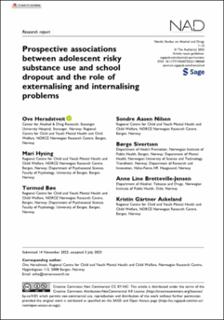| dc.contributor.author | Heradstveit, Ove | |
| dc.contributor.author | Hysing, Mari | |
| dc.contributor.author | Bøe, Tormod | |
| dc.contributor.author | Nilsen, Sondre Aasen | |
| dc.contributor.author | Sivertsen, Børge | |
| dc.contributor.author | Bretteville-Jensen, Anne Line | |
| dc.contributor.author | Askeland, Kristin Gärtner | |
| dc.date.accessioned | 2023-10-10T08:50:00Z | |
| dc.date.available | 2023-10-10T08:50:00Z | |
| dc.date.created | 2023-08-31T11:13:27Z | |
| dc.date.issued | 2023 | |
| dc.identifier.citation | Nordic Studies on Alcohol and Drugs (NAD). 2023, 1-15. | en_US |
| dc.identifier.issn | 1455-0725 | |
| dc.identifier.uri | https://hdl.handle.net/11250/3095403 | |
| dc.description.abstract | Background: The aim of the present study was to assess to what extent risky substance use (RSU) acts as an important risk factor for school dropout from upper secondary school in a prospective study of Norwegian adolescents, and how externalising and internalising mental health problems influenced this association. Methods: We used data from a large population-based survey (the youth@hordaland-survey), which included adolescents aged 16–19 years. The predictor variables were self-reported RSU. The survey was linked with prospective data from the Norwegian Education Database, following the adolescents to 21–23 years of age. The outcome variable was registry-based school dropout within five years after starting upper secondary school. The analyses were adjusted for sex, age, socioeconomic status, and externalising and internalising problems. Results: After adjustment for sociodemographic variables, all indicators of RSU were prospectively associated with school dropout (adjusted odds ratios 1.26–2.25; all p values <.01). While internalising problems only slightly changed these estimates, the associations were substantially attenuated by externalising problems. Still, all measures of RSU, except frequent alcohol intoxication, remained positively associated with school dropout in the fully adjusted models. For the youngest students, all associations between RSU and school dropout were significant. Conclusions: Adolescent RSU is a strong predictor for school dropout, and externalising problems explained a considerable proportion of this effect. Prevention efforts to reduce student substance could improve academic outcomes among upper secondary school students, and such efforts may benefit from also targeting co-occurring externalising problems. | en_US |
| dc.language.iso | eng | en_US |
| dc.rights | Navngivelse-Ikkekommersiell 4.0 Internasjonal | * |
| dc.rights.uri | http://creativecommons.org/licenses/by-nc/4.0/deed.no | * |
| dc.title | Prospective associations between adolescent risky substance use and school dropout and the role of externalising and internalising problems | en_US |
| dc.title.alternative | Prospective associations between adolescent risky substance use and school dropout and the role of externalising and internalising problems | en_US |
| dc.type | Peer reviewed | en_US |
| dc.type | Journal article | en_US |
| dc.rights.holder | © The Author(s) 2023 | en_US |
| dc.description.version | publishedVersion | en_US |
| cristin.ispublished | true | |
| cristin.fulltext | original | |
| cristin.qualitycode | 1 | |
| dc.identifier.doi | 10.1177/14550725231188568 | |
| dc.identifier.cristin | 2171324 | |
| dc.source.journal | Nordic Studies on Alcohol and Drugs (NAD) | en_US |
| dc.source.pagenumber | 1-15 | en_US |

